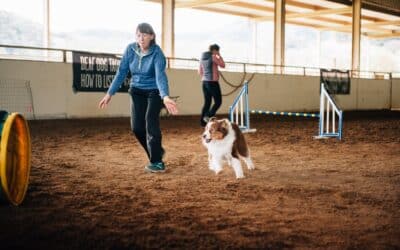Jumping over things is a fun and natural thing for dogs to do, but teaching your dog to jump on command can throw you into a whirlwind. After all the effort you’ve spent teaching your dog how to work with you on the ground, now you’re trying to get them airborne!
The good news is that teaching a dog to jump on command isn’t as hard as it seems. When you start teaching from the dog’s perspective, you’ll help your pup tap into their instincts and naturally do what they’re physically able to.
What to know before you start teaching your dog to jump
There are a few ground rules to cover before you get your pup up and soaring over obstacles:
- Jumping is natural for dogs, but that doesn’t mean they can tackle any height or distance. Just like humans, they have physical limits.
- Make sure your dog is at least 12 months old before you train them how to jump.
- Ensure your dog is fit and healthy with no injuries.
- Start low, and help your dog train up as they grow more comfortable and confident.
These are four basic things to keep in mind as you start deciding the best way to teach a dog to jump. And as we dive into the actual training, don’t forget the 3 Ps: patience, practice, and perspective!
Train your dog to jump from their point of view
You may see an elevated bar and think its no big deal. It’s even shorter than your dog, so they should be able to clear it with no problem, right? Not necessarily.
Jumping safely requires dogs to have a take-off and landing zone, which means they need more space than you may realize.
If you have multiple jumps, there needs to be at least 5 yards (4 to 5 meters) of space between jumps, for your dog to perform them safely.
When starting to teach your dog to jump, the bar should only be as high as your dog’s knee on the hind leg (hock) at the beginning. If this is easy for your dog (and they are over 12 months old) you can raise the bar to the height of their shoulder as a maximum. Always start low to avoid injury.
Getting started – Teach your dog to jump the easy way!
You can start by getting your dog to offer to go over the bar.
Place the bar on the ground for your first attempts. Your dog will have to get familiar with the obstacle itself, and grow comfortable crossing over it when it’s in their visual field. You can start by having them simply walk over it, then gradually increase speed and distance until they’re able to clear it in a straight line. Always throw or place the reward on the ground in front of the dog to have them looking forward at it and not at you, so they can focus on the task at hand.
For the first few sessions, keep the height the same and only ask your dog to jump a handful of times. After the first few sessions, if they are having fun and succeeding, you can increase the height and number of repetitions slowly. You want to protect their joints and muscles as they’re getting used to the motion.
Can I make my own dog jumps in agility?
Absolutely! We love backyard agility courses, and DIY obstacles are easier than you think! The easiest method we suggest is using two buckets and a broomstick! You can also adjust the height by using smaller buckets or even sturdy Tupperware bowls. Just make sure anything you use is safe and the bar can fall easily if it is knocked.
Here’s a full guide to our DIY agility obstacles.
Make jumping fun for your dog
New obstacles can make some dogs nervous. To combat any anxiety and prevent stress, make a game out of training and keep rewards high! After all, when your dog is having a great time, so do you. One option is to let your dog figure out how to jump on their own, then reward them when they successfully clear the obstacle.
Treats and toys always equal fun in a dog’s mind. Make sure you find out what reward your dog loves best before you start training. You could even lay out a few options and see which one your dog chooses.
The best way to keep things fun is to use our jump offering game. This game lets dogs use their brain in a different way, and it’s a blast to see their lightbulb go off when they understand what you’re asking.
You won’t need any jumps to start playing this game! Check out the video below for instructions.
Some final tips for teaching your dog to jump
Remember to take any training at your pup’s pace. Dogs always let us know what they’re capable of and what they’re comfortable with. Tap into their body language, and make sure they’re always showing signs that they’re happy and having fun (tail wagging, relaxed face and body, focused on the task, actively seeking the reward etc).
Some days, they may be more excited to train than others. That’s okay! Don’t let their lack of enthusiasm for jumping get you down. Instead, play a different game or go for a walk if they’re not feeling it that day, so they still get to have a great time.
When you have a strong connection with your dog, learning new things together becomes fun and natural. Every learning experience is an adventure, and training together will only bring you closer.
Join our Magical Connection Week Challenge for more fun training ideas you and your pup can enjoy.



